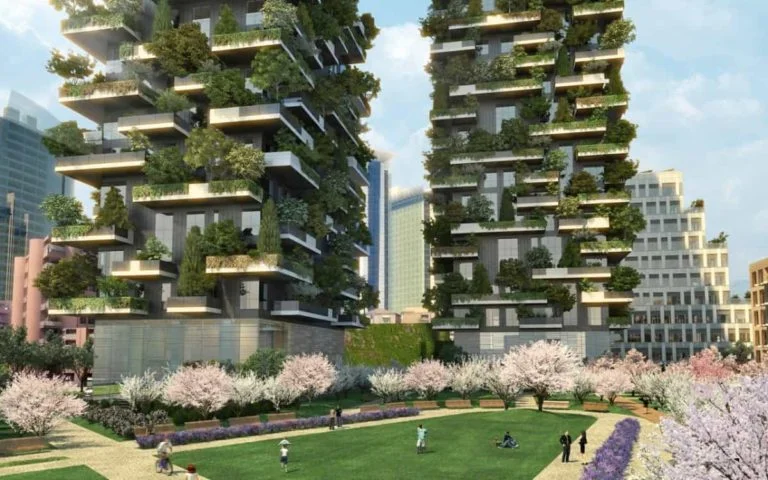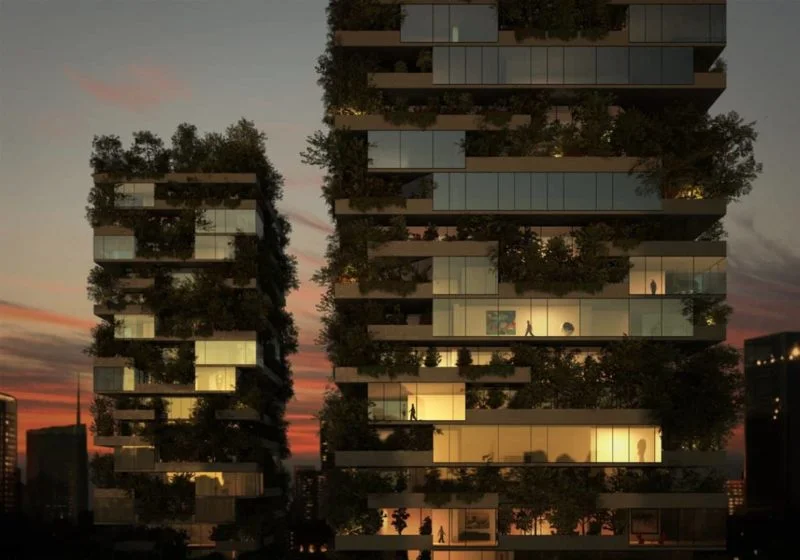Bosco Verticale: Greening The World

It all began with Bosco Verticale. And now Studio Boeri is ‘greenifying’ the world
By Chiara Spagnoli Gabardi
Architect Stefano Boeri has used his skills and love of the planet to create an eco-residential area in the Italian fashion capital. Meet Bosco Verticale, a.k.a. the Vertical Forest.
Boeri, along with Gianandrea Barreca, Giovanni La Varra, and all the associates at Boeri Studio, are extremely proud to have created this. Bosco Verticale is pair of residential towers that define Milan’s Porta Nuova district. The edifices have been designed to green up a generally grey city.
At 119 and 87 metres, the buildings can host up to 900 trees and over 2000 plants. They feature a wide range of species, creating a kind of mini-ecosystem in the city. Of course, different types of plants are used depending on how they react to the sun and elements.
And the results aren’t just beautiful – they’re beneficial to the health of urban dwellers, too.

Cleaner Air
The plants in Bosco Verticale help mitigate smog and produce more oxygen. These eco-skyscrapers are ideal for metropolitan reforestation, since they regenerate the environment and the urban biodiversity without expanding the city towards the suburbs.
In addition, the plants:
- capture CO2 and dust in the air
- produce humidity
- protect from acoustic pollution such as traffic
- reduce the need to mechanically heat and cool the tower’s apartments
- help mitigate the area’s urban heat island effect, especially during the summertime.
How It Works
Plant irrigation at Bosco Verticale happens through the filtering and reuse of the grey water produced by the building. Aeolian and photovoltaic energy systems work together with the aforementioned microclimate to increase the degree of energetic self sufficiency of the two towers.
This urban forest ambiance has been created thanks to botanists and horticulturalists. They were consulted by the engineering team to ensure that the structure could bear the load imposed by the plants.
Some feared that the wind gushing through the trees will make the towers topple. But there’s no need to worry–these buildings are as strong as Sequoia. And as beautiful, too.

A Home For All
The project was conceived as “a home for trees that also houses humans and birds.” This philosophy not only defines the urban and technological characteristics, but also the architectural and expressive qualities of the Vertical Forest.
During the various seasons, the variety of nuances and shapes of the plant structure generate a large iridescent landmark, that is utterly recognisable in Milan’s skyline. In fact, the image of the Bosco Verticale has become the new symbol of this Italian city in just a few years.
The foundation work for the plant components was the result of three years of studies conducted together with a group of botanists and ethologists. Beginning in the summer of 2010, the plants destined to be planted on the towers were pre-cultivated in a special botanical nursery, near Como, in order to get them used to living in conditions similar to those of the Porta Nuova neighbourhood.
Still today the most fascinating trait for the maintenance of this mesmerising structure is the team of “Flying Gardeners.” Through the use of mountaineering techniques, they are able to descend from the roof of the buildings to check the condition of the plants. They provide quite a sight for tourists and locals alike!

A Concept That Travels
The Bosco Verticale adventure began in 2014, and is still thriving to this very day. Due to the success of the concept, Stefano Boeri was asked to bring his expertise in green architecture to China.
His firm was tasked with an even bigger project: the Nanjing Vertical Forest. This consists of two new forest towers in the Chinese city Nanjing. The towers will serve as a model for expanding the style to three full cities in China. This construction will mark the first ever Vertical Forest built in Asia. The ultimate hope that it will represent the beginning of a more sustainable approach for China.
In fact, Boeri plans on expanding the effort to the Chinese cities of Liuzhou and Shijiazhuang. The Forest Cities represent an urban vision for a a new generation. It will be capable of becoming a model of sustainable growth in a large country with huge migration to cities.
Liuzhou’s project is particularly ambitious, since this Chinese city has around one and a half million inhabitants. Located in the mountainous province of Guangxi, it is one of the world’s most smog-affected urban areas due to overpopulation. Tree-covered towers will surely be welcome!

A Porous Model
The plan is to cover the whole urban structure in green, hosting about 40,000 trees and 1 million plants from more than 100 different species. The flora will absorb about 10,000 tons of CO2 and 57 tons of micro-particles every year, producing about 900 tons of oxygen. It will also generate a barrier against acoustic pollution and increase the biodiversity of living species through the generation of a rich ecosystem. Birds, insects and small animals surrounding Liuzhou should find a home here.
The new Liuzhou Forest City will be a truly “porous model”. In other words, an urban organism that is sensitive and attentive to the specific qualities and values of the environment.
This design approach develops naturally starting from the planimetric layout, designed to integrate harmoniously with the geography of the surrounding mountains, following their morphology and incorporating the qualities of the local landscape. This approach also corresponds to a careful study of the technological, infrastructural and distribution characteristics of the large urban complex.
It all started with Bosco Verticale. And now, the Shijiazhuang Forest City will become a sustainable metropolis with low energy consumption. If only all cities were so!

Images: Boeri Studios
- Eco Friendly Artists Who Will Blow Your Mind - July 27, 2025
- 10 Of The Best Non Toxic Home Fragrances - November 21, 2023
- 12 Sustainable Home Gift Ideas For Christmas - November 17, 2023









